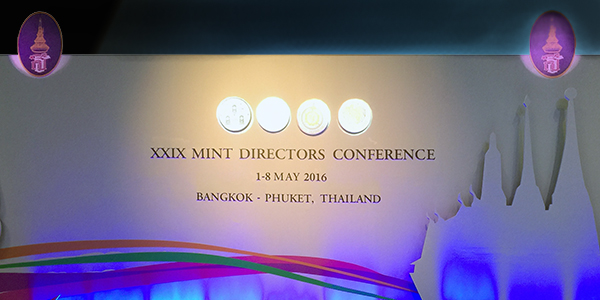
By Charles Morgan for CoinWeek …..
I’ve been home about a week from my trip to Thailand where CoinWeek was invited to be a presenter at the XXIX World Mint Director’s Conference. I have to say that the Royal Thai Mint did a fantastic job hosting the event in the heart of Bangkok, a world-class city almost indescribable in the sheer scale of its towering skyscrapers and busy streets teeming with people, cars, and motorbikes. Thailand is known to many as the “Land of Smiles”, and those in attendance–mostly mint directors and key personnel from leading state and private mints from around the world–were treated to some of the friendliest people and amazing food that I’ve ever had the pleasure to experience.
And I’d be remiss if I didn’t mention the fantastic cultural exchange, including a visit from Her Royal Highness Princess Shrindihorn.
But beyond the pomp and circumstance, the reason for the gathering was to share information and expertise, and to find common ground for the sake of preserving and growing the coin minting industry.
As a coin collector, I found the gathering insightful on a number of levels: the mints, despite being competitors for collector and investor dollars, do see a need to work together on key issues, such as security and pushing back against the well-funded lobby of the banknote industry. Inflationary pressures impact coin production in a very real way and the mints must counter the continued production of low-denomination banknotes or risk extinction.
The Mints also differ on many issues. While the production of bullion coins has been a mainstream market segment for many of the world’s mints since the 1980s, some see the production of bullion coins as detrimental to the basic mission of a state mint. There was lively discussion on the pros and cons of the bullion coin business and, if one were to consider the topic on a granular level, some could make the argument that state mints that produce bullion coins are in essence undermining the whole fiat currency system, but this may be a topic for another day.
My presentation however, was not about any of these issues.
Instead, I traveled to Bangkok to present a case for the commemorative and NIFC (Not Intended for Circulation) coin-issuing mints to consider the challenges of maintaining a secondary market for their products.
One need not be a professional coin market analyst to understand that the rare coin industry is mostly built on the recycling of a finite inventory of coins from the past. The mints, of course, contribute to this inventory, but in this postmodern era of coinage they produce far too many coins and offer them at too high a cost to insure that these coins will maintain their price in the long run.
We know all too well that many modern issues, even those that are popular out of the gates, do not fare well in the secondary market in the long term. Combating this problem won’t be easy, but we think that the mints have a role in the matter and do bear some of the responsibility for the product they create.

In essence, the issue comes down to market sustainability and branding. No coin collector buys a coin with the intent of throwing it away when they grow tired of it. The cold hard truth of the collector coin market is that we’re all just temporary owners of the coins we buy. And while the U.S. market is more investor-oriented than any other coin market in the world, it makes sense for the industry to research and develop ways of either capitalizing the secondary market for their past issues (when there’s a need) or means of sustaining interest in past product so tomorrow’s collector will find today’s modern issues as interesting as we do.
As daunting as it might seem to stand up in front of representatives of all of the world’s major mints to deliver this message, I found strength of purpose from my belief that sustaining the collector market in the long term is in the minting industry’s best interests. Especially at a time when the very physical reality of money is increasingly challenged by digital forms of payment, aka the dreaded “cashless society”.
Also, by carrying this message, we represent the interests of their customers–you, our CoinWeek readers. In making light of the collectors’ impulse to turn a profit from a coin purchase, I told the mint directors that “inside the heart of every collector is a greedy little speculator”. In actuality, I don’t think any of us expects every coin we ever buy to pony up the goods, but we do hope that if we spend $100 of our hard-earned cash for a beautiful modern collector coin that we won’t be left totally upside down, having nothing more to show for it than a fancy piece of bullion.
The coin market has already lived through the collapse of that system when the bottom fell out of the Franklin Mint’s much-hyped marketing plan back in the 1970’s. We certainly don’t want a repeat of that, when the mints need collector support more than ever.




